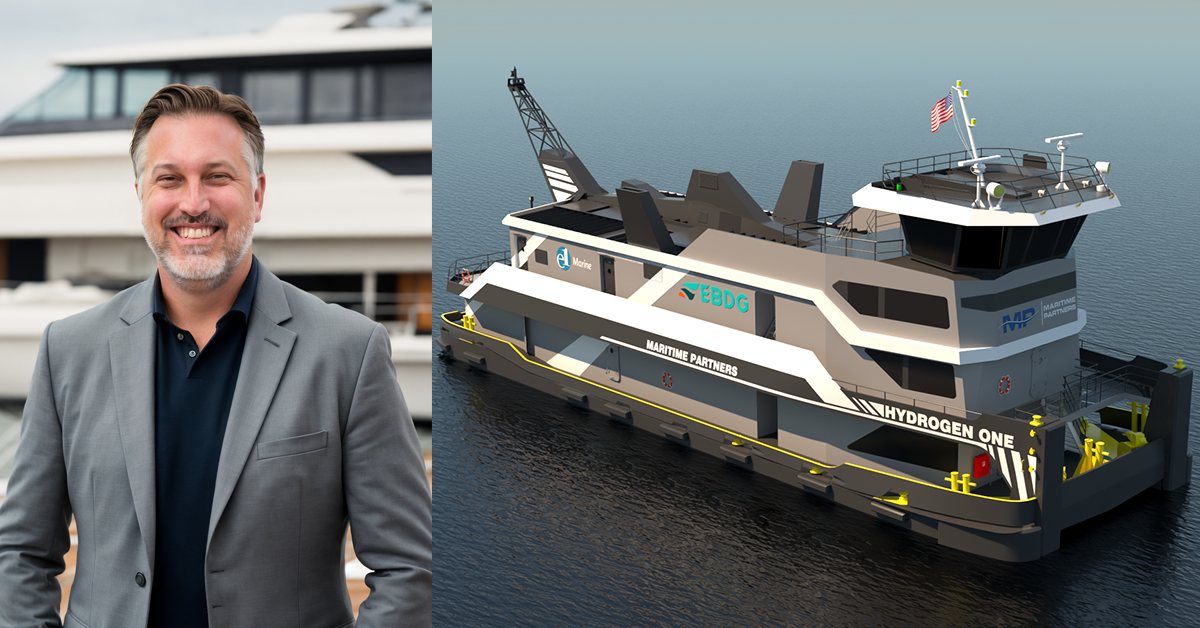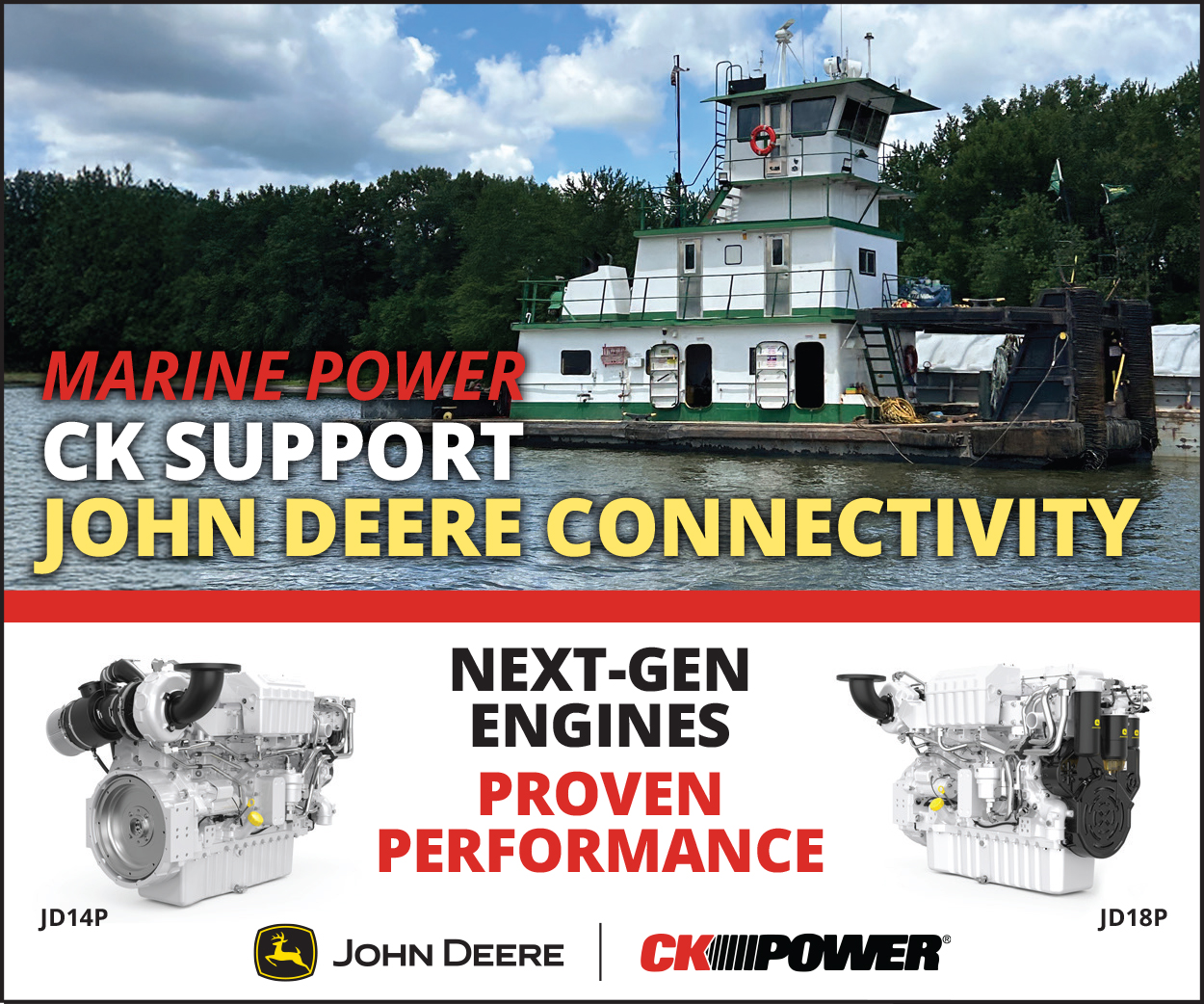Dave Lee is vice president of technology and innovation for Maritime Partners and executive director of e1 Marine. In his role with Maritime Partners (MP), Lee tracks new technologies impacting the maritime industry both now and in the future. With e1 Marine, Lee focused on developing the company’s team and technology, which involved reforming methanol into hydrogen for a variety of applications. Lee discussed recent developments for both companies in a recent interview with The Waterways Journal.
WJ: It’s been just over six months since MP announced the acquisition of e1 Marine. There was already familiarity between the companies, with e1’s methanol-to-hydrogen technology planned for Maritime Partners’ forthcoming Hydrogen One towboat. What made the acquisition a good fit for both e1 and MP?
DL: It was a great fit because we are committed to e1 Marine as a technology, and we believe in it enough that we are developing the Hydrogen One based on the technology. We also see methanol as a great transition fuel from diesel, and with the reformer technology, we can pair it with other mature technologies to develop projects and lead the industry into a time of greatly reduced emissions compared to today.
WJ: Since its founding in 2015, Maritime Partners has grown not just in size but also in scope, from building and owning traditional towboats to developing a first-of-its-kind hydrogen-powered towboat. Why does that make sense for MP? How might MP be capable of tackling those types of leading-edge projects more so than other companies?
DL: At Maritime Partners, we are committed to leading the industry in many ways, and technology is only one of those. We are a very nimble company that is built on great talent and employees. With that, we have a lot of different skills sets we can pull from to take on some of these challenges and projects that others might shy away from. It was awesome to watch the evolution of Maritime Partners from the outside, and now that I am inside, I am really excited to utilize my skill sets in tandem with the others on the team to keep pushing the ball forward.
WJ: Can you give a status update for Hydrogen One?
DL: Hydrogen One has been quiet for a bit as we have been working on a lot of behind-the-scenes objectives to develop the project in a thoughtful and successful way. One instance is the hard work we did to receive the U.S. Coast Guard Design Basis Agreement (DBA) mid-last year. This work was extensive, but to the outside world, it doesn’t include steel on the ground, so there is a sense that nothing is happening. The opposite is really true. It is not every day that the U.S. Coast Guard needs to develop a rule set for a boat that will use methanol as a fuel, methanol reforming technology, fuel cells and batteries.
Following the DBA approval, we had an opportunity to improve the overall boat by upgrading the reformer technology to the newest larger generation. With this change in power plant, we also took the opportunity to redesign the boat to a more standard footprint. All of that takes time, and we are in the stage currently of developing scoping documents for shipyard RFI/RFP that will be released in the first half of this year.
WJ: What are some other applications you’re looking at for e1 Marine’s technology? Will shore power be another application for that?
DL: Yes, at e1 Marine we have sold our first containerized solution that will be installed in California. We are focused, not only on marine projects, but on port projects as well, whether the technology be for vessel shore power, port equipment, battery charging using methanol reforming over diesel gensets, hydrogen production onsite utilizing methanol versus trucking it in from another state, etc. There is growing demand, not only on the equipment side where the reformer technology could be used, but also on the port side where it is more aligned with supporting infrastructure. We are tracking a lot of great opportunities, and not a single one is the same.
WJ: I should’ve asked this first. How does it work?
DL: The easiest way to think about it is fuel production, fuel storage and fuel use to get to the full system. First, the fuel, hydrogen, is produced using the reformer technology via a methanol and water mixture. From there, the hydrogen is stored in buffer tanks and either immediately used by the fuel cells or held in the tank until the fuel cells demand fuel. Finally, the fuel cells utilize the hydrogen to produce the electricity that is needed either for house power, propulsion or to charge the onboard batteries. All of this is automatic, so you don’t have to choose where the power goes. Currently, in the early stages, each component is separate and requires outside integration to make all of it work together. Stage two in the development process is developing the integrated system that allows for simpler adoption in new or existing vessels or to be utilized in building blocks for a containerized solution in ports.
WJ: How does what you’re doing with Hydrogen One compare with what’s going on in the rest of the world?
DL: Everyone is looking for a solution for the future, and there are spots throughout the world that need that solution sooner than others. The European Union, California and spots throughout Asia need a solution now due to regulation. The key for the operators in these regions is a technology that has already been adopted and utilized in a similar application. The Hydrogen One and other projects that e1 Marine is developing and delivering on will build the confidence in the technology and give those operators the option of our system. Then, we can take them to or point them to the equipment in operation to settle their questions.
WJ: Does that mean you are actively marketing the hydrogen technology outside of the United States? If so, where, to what degree, and is anything under construction or in operation yet?
DL: Yes, we are a global technology provider, so on a weekly basis the team and I are in conversations with operators, designers, municipalities, etc., concerning our technology. We are focused on educating our customers and potential customers on the technology and system and then helping them find the right solution to meet their needs. To this point, there is the same technology in operation throughout the globe, but the marine projects to date have come from the United States, with the caveat that we hope to have some globally that we can brag about soon!
WJ: Around the world, there seems to be a focus on securing a reliable energy supply that’s also emissions conscious. Would you say your methanol-to-hydrogen technology fits that trend?
DL: What we are finding is that the customer selects the fuel they feel is easily adopted and also most comfortable to them. That fuel may be methanol, LNG, ammonia, etc. We are bullish on methanol because it is a product that is moved in very large quantities today, thus operators are familiar and comfortable with it. With methanol, there is no need for special pressure tanks or cryogenics to keep it in a density that is feasible. Finally, there is technology today that can utilize methanol such as the reformers from e1 Marine. So, yes, I think methanol meets the trend globally in many ways.
WJ: How do you move from a demonstration project like Hydrogen One to mainstream, or from a single application to scalable operation?
DL: Through hard work, a great team and by developing a great product by listening to customer’s’ needs and continuing to build on momentum that you get from one win at a time. That all sounds easy, but there are challenges with each. We faced it with the Hydrogen One already where, to meet the vessel demands and make the vessel what the customer really needs, we made the decision to hold back slightly and develop the vessel with the next generation of e1 Marine’s product. The final one word is patience. Tesla wasn’t the Tesla we know today in year one, but they were committed to their technology and knew they had something the customer needed.
WJ: Any closing thoughts?
DL: I would like to say that, in my last several years in the new technology space, customers really are struggling to decide on what technology to utilize for an asset that will last for many, many years. This isn’t a car that we seem to dispatch in just a couple years. We are building assets that last upwards of 60 years. How do you make the right decision for others that will need to deal with your decisions after you are gone from the company? My suggestion is to do as much research as possible, talk to as many people as you can, and pick a technology and a team that is committed to the technology as much as you are committed to making the right decision. It is tough, but we are close-knit in this industry, and we want to see projects succeed.




